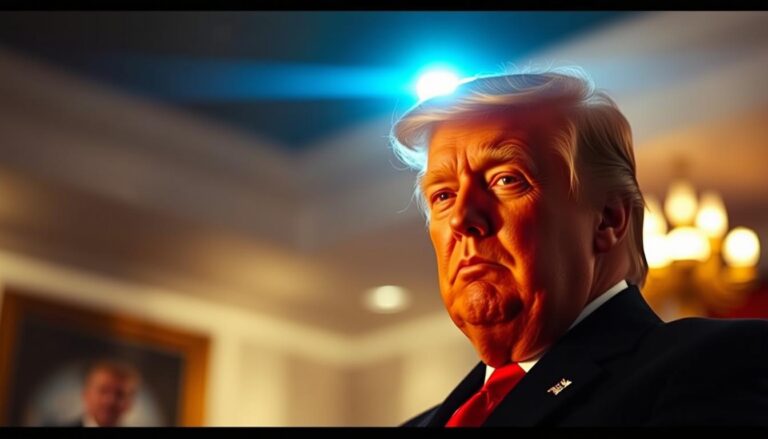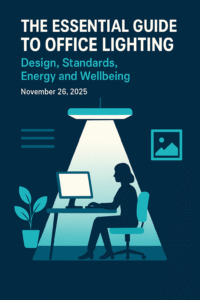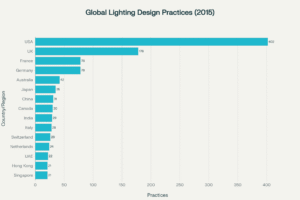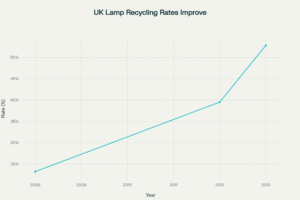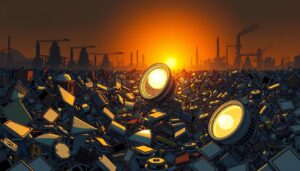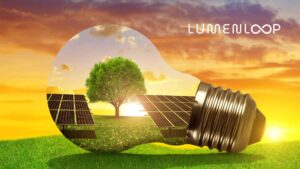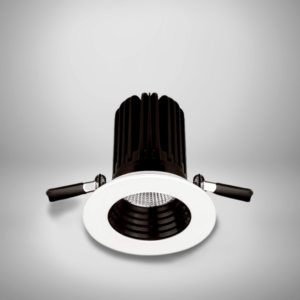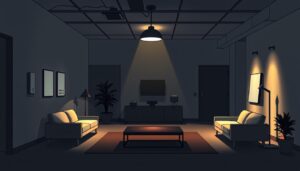It’s official: the battle for the choice of American’s lighting fixtures has reached the highest office in the land. President Donald Trump, ever the showman, has signed an executive order promising Americans the “freedom to choose” their light bulbs.
Yes, amidst the weighty matters of global diplomacy, international wars, domestic policy and a certain billionaire that needs a history lesson, the humble light bulb has found itself thrust into the limelight.
Yes, amidst the weighty matters of global diplomacy, international wars, domestic policy and a certain billionaire that needs a history lesson, the humble light bulb has found itself thrust into the limelight.
Dubbed “Unleashing American Energy,” the order sounds like it belongs on the cover of a superhero comic. While it also tackles state mandates for electric vehicles and energy-guzzling appliances like dishwashers and washing machines, it’s the inclusion of light sources that’s raising eyebrows—and, in some cases, smirks.
Could this be the incandescent bulb’s big comeback? Lighting experts quickly point out that reviving Thomas Edison’s dimmer legacy would require an act of Congress to undo federal efficiency standards. But, then again, Trump has never let technicalities like “laws” or “scientific consensus” dim his enthusiasm.

Trump Doesn't Seem to Like LEDs
Let’s not forget his glowing nostalgia for incandescent lighting during his first term. “I look better under an incandescent light,” he declared to a rally crowd in North Carolina, as if America’s real energy crisis was his perceived complexion under LEDs. And while he warned of the supposed toxic horrors of broken LEDs, he assured the audience that his mission was simple: to liberate their holiday décor from the tyranny of modern efficiency standards.
And so, as we revisit the glow of his incandescent ambitions, one can’t help but chuckle at the idea that, in the end, maybe it wasn’t about light bulbs at all. Maybe it was about a man, a stage, and a beam of light that didn’t dare make him look less than presidential.
Someone could just explain how CRI works but let’s not pretend science or facts is going to sway his opinion.
The Great Bulb Debate: Understanding the Controversy
Here we are at the big bulb debate. The incandescent vs led argument has been ongoing, with each side highlighting its differences in energy use, and disposal of bulbs when considering their environmental impact.
Of course, this isn’t the first time Trump has made lighting—or, more specifically, his lighting—sound like a matter of national security. The man’s disdain for LEDs was practically a subplot of his presidency, right alongside tariffs and fast-food feasts. He didn’t just dislike them; he made them a cultural flashpoint, as though choosing between warm incandescents and harsh LEDs was akin to picking sides in the Cold War.
His argument? LEDs are too blue, too unforgiving for anyone trying to pull off a golden tan or hide a sleepless night. Never mind their energy efficiency or longevity—when it came to lighting the MAGA stage, it was all about the warm, nostalgic glow of yesteryear.
And who could forget his warnings about LEDs being hazardous waste sites in disguise? “Very dangerous, with all the gases,” he said, possibly confusing them with something out of a 1950s sci-fi movie. To hear Trump tell it, breaking an LED bulb was less of an accident and more of a full-scale hazmat emergency.
LEDs Vs Incandescent
We are at the forefront of the lighting technology dispute, aiming to educate our customers on the various lighting technologies. As we engage in the sustainable lighting debate, it’s vital to weigh the pros and cons of each technology.
Key lighting technologies include:
- Incandescent lighting
- LED lighting
- Fluorescent lighting
Each technology has distinct features. Understanding these differences is essential for making informed lighting choices.
Exploring these technologies can lead to a more sustainable future. It reduces energy use and waste. The lighting technology dispute is complex, but by examining the facts, we can positively impact the environment.
Our company is dedicated to delivering top-notch lighting solutions. We aim to meet our customers’ needs while promoting sustainability. Together, we can forge a brighter, more sustainable future.
| Lighting Technology | Energy Efficiency | Environmental Impact |
|---|---|---|
| Incandescent | Low | High |
| LED | High | Low |
| Fluorescent | Medium | Medium |
The Science Behind Skin Tone and Artificial Lighting
The bulb debate often centres on how artificial lighting affects our skin tone. The colour temperature of lighting significantly influences how our skin looks. This is why the energy-efficient lighting discussion extends beyond just saving energy. It’s also about creating a more flattering and comfortable environment.
Different lighting technologies have varying impacts on skin tone. Some bulbs produce a warm, yellowish glow, while others emit a cool, bluish light. Grasping the science behind these effects heps make sense of smart lighting choices.
Let’s explore the connection between skin tone and artificial lighting:
- Colour temperature: This refers to the warmth or coolness of a light source, measured in Kelvin (K). A lower Kelvin rating indicates a warmer light, while a higher rating indicates a cooler light.
- Lighting technologies: Different types of bulbs, such as incandescent, LED, and fluorescent, can produce distinct effects on skin tone.
- Personal preferences: Individual preferences for lighting can vary greatly, with some people preferring a warm, cozy glow and others opting for a bright, cool light.
By delving into the science behind skin tone and artificial lighting, we gain a deeper understanding of the bulb debate. This knowledge helps us make more informed choices about our lighting options. It contributes to a more sustainable and energy-efficient lighting discussion.
Energy-Efficient Lighting: Separating Fact from Fiction
We aim to give our customers the best advice on energy-efficient lighting. This helps them make smart choices about their lighting. In our energy-efficient lighting discussion, it’s vital to distinguish truth from myth. The eco-friendly bulbs controversy has led to a lot of debate. Many are unsure about the advantages and disadvantages of various lighting technologies.
Energy-efficient lighting offers several benefits. It cuts down on electricity use, lasts longer, and saves money. For example, these lights can use up to 75% less electricity than traditional bulbs. Also, LED bulbs can last about 25,000 hours, much longer than incandescent bulbs at 1,200 hours.
When looking at energy-efficient lighting, consider these points:
- Adopting energy-efficient lighting globally could cut global carbon emissions by 1.7 gigatons per year by 2030.
- LED lights are more efficient than traditional bulbs, leading to a yearly reduction of about 1,000 pounds of greenhouse gas emissions for a typical home.
- Lighting accounts for about 32% of commercial sector electricity use, making energy-efficient options key for cost savings.
Switching to energy-efficient lighting can save households $100 to $200 annually on energy costs. As we explore the eco-friendly bulbs controversy, it’s evident that energy-efficient lighting is vital. It helps reduce our environmental impact and supports sustainability.
Environmental Impact of Different Bulb Types
Understanding the environmental effects of our products is key to delivering sustainable solutions. The environmental impact of bulbs is a vital part of the sustainable lighting debate. We must look at the carbon footprint, manufacturing, and disposal of various lighting technologies.
The environmental impact of bulbs varies significantly. For instance:
- Incandescent bulbs consume more energy and have a shorter lifespan, leading to a higher carbon footprint.
- LED bulbs, being more energy-efficient and lasting longer, have a lower environmental impact.
- Fluorescent bulbs, while less carbon-intensive than incandescent bulbs, contain toxic materials like mercury.
In our quest for sustainable lighting, we must engage with the sustainable lighting debate. By opting for energy-efficient and eco-friendly lighting, we can significantly reduce our carbon footprint. This contributes to a greener future for all.
The Economics of Modern Lighting Solutions
The choice to adopt new lighting technologies is often swayed by the wattage comparison debate and the eco-friendly bulbs controversy. It’s vital to weigh both the upfront costs and the long-term savings when considering modern lighting solutions. The energy consumption of each technology is a key factor in determining its economic viability.
Several factors influence the economics of lighting solutions, including:
- Initial investment in new lighting technologies
- Long-term energy savings and reduced maintenance costs
- Impact of the wattage comparison debate on energy efficiency
- Role of the eco-friendly bulbs controversy in driving sustainable choices
Choosing sustainable lighting solutions can help reduce energy consumption and lower environmental impact. As we navigate the complexities of the wattage comparison debate and the eco-friendly bulbs controversy, making informed decisions is critical. We must consider both the economic benefits and the environmental impact of our choices.
| Lighting Technology | Initial Cost | Long-term Savings | Energy Consumption |
|---|---|---|---|
| LED Bulbs | Higher | Substantial | Lower |
| Incandescent Bulbs | Lower | Minimal | Higher |
Policy Changes and Their Impact on Lighting Choices
We are at the forefront of the lighting technology dispute, dedicated to advising our customers on the latest in lighting needs. As a leading (British) lighting manufacturer, we find it critical to keep abreast of policy shifts.
Several factors are shaping our lighting choices:
- Government regulations and industry standa
- Energy efficiency and environmental impact
- Cost and return on investment
Our mission is to fully grasp the policy changes affecting our lighting options. We aim to discuss the implications of these shifts on the lighting sector. We will shed light on the opportunities and hurdles these changes bring, underlining the significance of the sustainable lighting debate within the lighting technology dispute.
We strive to revolutionise the lighting industry, making every luminaire 100% regenerative and refurbishable. This move aims to eradicate all lighting-related e-waste. By keeping abreast of policy changes and their effects on lighting choices, we can forge a more sustainable future together.
Smart Lighting Technologies: The Future of Illumination
We stand at the threshold of a lighting revolution, with smart technologies reshaping our interaction with light. Amidst the lighting technology dispute, sustainable lighting solutions are key to illuminating our future. They promise to redefine how we perceive and use light.
The advent of IoT in lighting has ushered in an era of customizable and energy-efficient solutions. This evolution not only enriches our living experience but also fuels the sustainable lighting debate. It’s about reducing energy use and environmental impact.
Smart lighting technologies bring several advantages:
- They are energy-efficient, saving costs.
- They enhance comfort and user experience.
- They offer flexibility and customization.
- They contribute to a greener future.
As we progress, focusing on sustainable lighting is imperative. We must resolve the lighting technology dispute by adopting smart technologies. This approach prioritizes energy efficiency and environmental stewardship. Together, we can forge a brighter, more sustainable world.
| Technology | Benefits | Challenges |
|---|---|---|
| IoT Integration | Enhanced user experience, energy efficiency | Security concerns, compatibility issues |
| Customizable Lighting | Increased flexibility, improved comfort | Higher upfront costs, complexity |
| Energy Management Systems | Energy savings, reduced environmental impact | Initial investment, maintenance requirements |
Making Informed Choices: A Professional's Guide
In the midst of the bulb debate, it’s vital to examine the factors that shape our decisions. The energy-efficient lighting discussion demands a careful evaluation of various technologies’ benefits.
Our strategy revolves around crafting a complete lighting solution tailored to each space’s specific requirements. We look at energy efficiency, cost-effectiveness, and environmental impact. This approach enables us to design lighting systems that cut energy use and costs.
Professionals should consider several key aspects:
- Assessing the energy efficiency of different lighting technologies
- Evaluating the cost-effectiveness of various lighting solutions
- Considering the environmental impact of lighting choices
By making well-informed decisions, we contribute to a greener future. As a lighting manufacturer, we aim to offer our customers precise and detailed advice. This enables them to make informed choices about their lighting needs.
Our ultimate goal is to forge a future where every luminaire is 100% regenerative and can be refurbished, eliminating all lighting-related e-waste. Through collaboration, we can realize this vision and usher in a brighter, more sustainable era for everyone.
Trump's View of Climate Change
When it comes to climate change, Donald Trump’s stance has always been… let’s say, unconventional.
During his presidency, he famously dismissed the issue as a “hoax,” often downplaying its urgency and impact with a wave of his hand and a tweet or two. He pulled the United States out of the Paris Climate Agreement, rolled back numerous environmental regulations, and repeatedly voiced his skepticism about scientific consensus.
Instead, he championed coal, oil, and natural gas as cornerstones of American energy independence. His views seemed to frame environmental concerns as little more than obstacles to economic growth, with a sprinkling of doubt about whether rising temperatures were anything more than “just weather.”
In typical Trump fashion, his rhetoric often leaned toward the theatrical, once suggesting that wind turbines “kill all the birds” and joking that we could solve climate issues by just having “clean air and clean water.” Subtle? No. Predictable? Absolutely.
Conclusion: Illuminating the Path Forward
Our journey through the lighting debate reveals a clear path to a sustainable future. It hinges on adopting eco-friendly lighting technologies. Manufacturers must champion sustainable lighting solutions, cutting waste and guiding consumers towards better choices. Switching to energy-efficient, durable bulbs is a step towards a circular economy and a greener future.
The eco-friendly bulbs controversy underlines the necessity for transparency and education. Consumers need to grasp the environmental effects of their lighting choices, from carbon emissions to production methods. It’s our duty as industry leaders to offer accurate, unbiased information. This enables our customers to select options that support their sustainability aspirations.
This shift presents a chance to reshape the lighting industry, making every fixture 100% regenerative and refurbishable. By closing the loop, we can eradicate e-waste and usher in an era of sustainable, circular lighting. United, we can forge a path towards a brighter, more eco-aware world.
FAQ
What is the bulb debate?
The bulb debate centres on the merits and drawbacks of various lighting technologies. This includes incandescent, LED, and fluorescent bulbs. It has significant implications for energy efficiency, environmental impact, and the future of the lighting industry.
What are the origins of the modern lighting discussion?
The modern lighting discussion began with growing awareness of traditional lighting’s environmental impact. It has been influenced by political and regulatory changes, as well as public perceptions and media coverage.
What are the different types of lighting technologies and their impact on the environment?
The main lighting technologies are incandescent, LED, and fluorescent bulbs. Each has its own energy efficiency, lifespan, and environmental impact. These factors are critical when choosing lighting solutions.
How does artificial lighting affect skin tone?
Artificial lighting’s colour temperature greatly affects skin tones. Colour rendering index and correlated colour temperature influence the light’s warmth or coolness. This, in turn, affects how skin tones appear under different lighting conditions.
What are the benefits and drawbacks of energy-efficient lighting?
Energy-efficient lighting, like LED and fluorescent bulbs, offers energy savings and reduced environmental impact. Yet, there are drawbacks, including higher initial costs and concerns about colour quality and human-centric lighting.
What is the environmental impact of different bulb types?
The environmental impact of bulbs varies widely. Factors like energy consumption, manufacturing processes, and disposal considerations all affect the environmental footprint of different lighting solutions.
How do the economics of modern lighting solutions compare?
Energy-efficient lighting may have higher initial costs but can lead to significant long-term savings. Understanding the total cost of ownership is key to evaluating the economic viability of different lighting technologies.
How have policy changes impacted lighting choices?
Government regulations, industry standards, and evolving consumer preferences have shaped the lighting market. Staying informed about these changes is essential for making informed lighting decisions.
What are the key features of smart lighting technologies?
Smart lighting technologies, like IoT-enabled devices and customisable solutions, offer energy management, personalization, and intelligent control. Understanding their benefits and challenges is vital for future-proofing lighting decisions.
What are the key factors to consider when choosing lighting solutions?
When choosing lighting technologies, consider energy efficiency, sustainability, cost-effectiveness, and user needs and preferences. A holistic approach to lighting design ensures informed and optimal choices.
